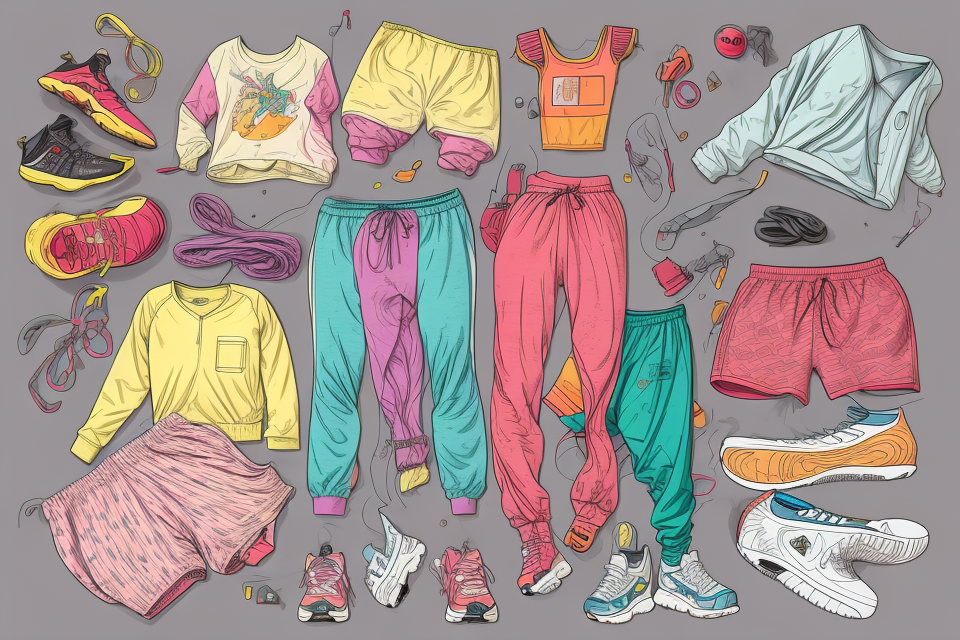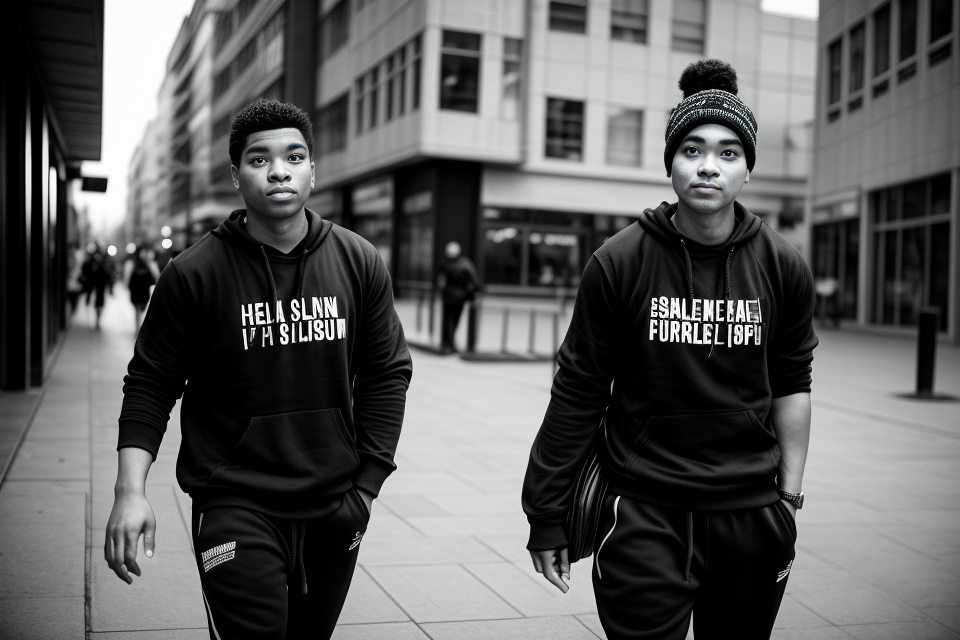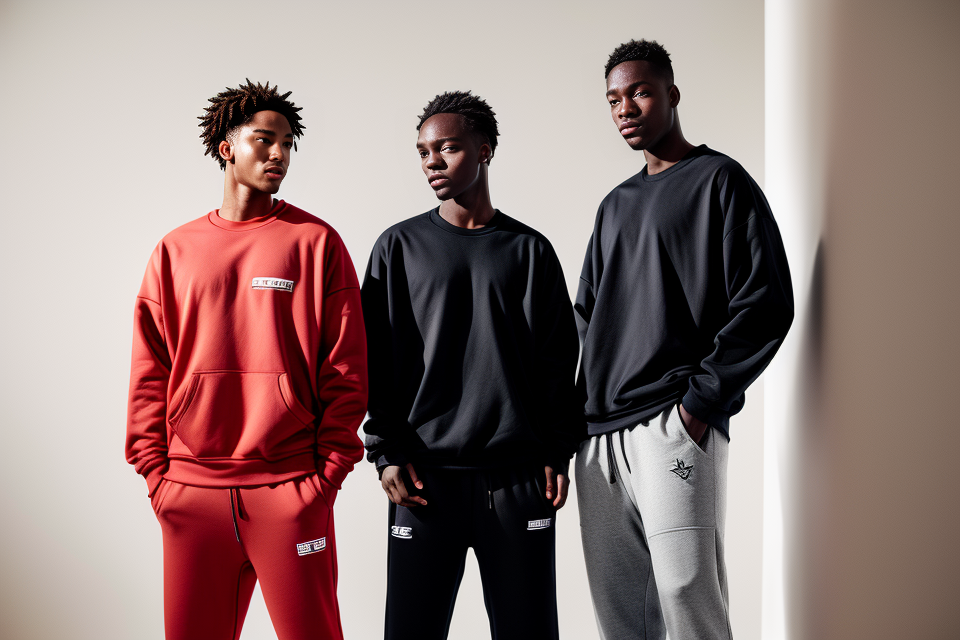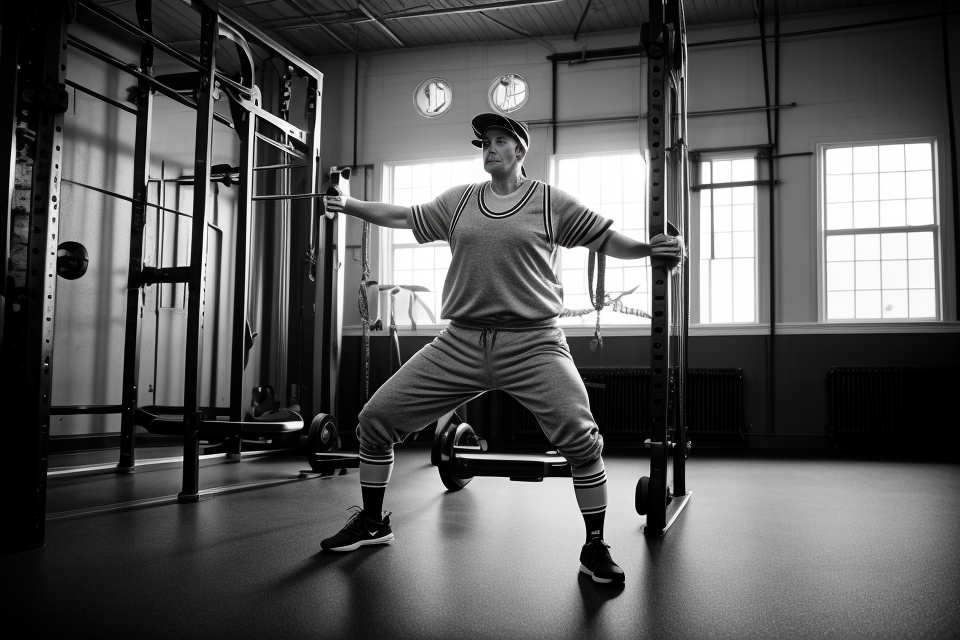Sweatpants and sweatshirts have become a staple in everyone’s wardrobe, and it’s no secret why. The feeling of coziness and comfort they provide is unmatched. But have you ever wondered why sweats are so comfy? The answer lies in the materials they are made of and the science behind them. In this article, we will take a deep dive into the world of sweats and explore the reasons behind their cozy feel. Get ready to uncover the secrets behind one of the most comfortable pieces of clothing.
Sweatpants and sweatshirts are often considered some of the most comfortable clothing items to wear, and there is a scientific reason for this. The fabric used in sweats is typically made from a blend of cotton and synthetic fibers, such as polyester or nylon. These fibers are designed to wick moisture away from the body, which helps to keep the wearer dry and comfortable. Additionally, the loose-fitting design of sweats allows for freedom of movement, which can contribute to their comfortable feel. The softness and flexibility of the fabric also add to the overall comfort of sweats.
Understanding the Science Behind Sweats’ Comfort
The Role of Fiber Types in Comfort
When it comes to the comfort of sweatpants, the type of fibers used plays a crucial role. Natural and synthetic fibers are the two main categories of fibers used in clothing, and each has its own unique properties that can affect how comfortable sweatpants feel.
Natural vs Synthetic Fibers
Natural fibers, such as cotton, wool, and silk, are derived from plants or animals and have been used for centuries to make clothing. These fibers are typically soft and breathable, which makes them comfortable to wear. However, they can also be more expensive and may not be as durable as synthetic fibers.
Synthetic fibers, on the other hand, are made from man-made materials such as polyester, nylon, and spandex. These fibers are often more affordable and can be made to feel soft and comfortable as well. However, they may not breathe as well as natural fibers and can be less environmentally friendly.
The Importance of Softness and Stretch
Regardless of whether the fibers are natural or synthetic, the softness and stretch of the fabric can greatly affect the comfort of sweatpants. Soft fabrics are gentle on the skin and feel pleasant to touch, while stretchy fabrics allow for a wider range of motion and comfort.
Additionally, sweatpants that are made with a blend of fibers can provide the best of both worlds. For example, a blend of cotton and spandex can offer the softness and breathability of cotton with the stretch and durability of spandex.
Overall, the type of fibers used in sweatpants plays a significant role in their comfort. Soft and stretchy fabrics, whether made from natural or synthetic fibers, can provide a comfortable fit and feel.
The Impact of Fabric Structure on Comfort
The comfort of sweatpants or sweatshirts is largely influenced by the fabric structure. The following factors play a crucial role in determining the comfort level of sweats:
Pile Density and Loft
Pile density refers to the number of fibers per unit area in a fabric. Higher the pile density, the thicker and more comfortable the fabric. Loft is the amount of air trapped between the fibers, which determines the insulation and warmth of the fabric. Sweats with higher loft tend to be warmer and more comfortable.
Weave Patterns and Their Effect on Texture
The weave pattern of a fabric determines its texture and feel. Sweats can have different weave patterns such as fleece, jersey, and interlock. Fleece has a dense, fluffy texture that makes it extremely warm and cozy. Jersey has a smooth, tightly woven texture that is lightweight and breathable. Interlock has a double-sided texture that is soft and comfortable. The weave pattern of the fabric can greatly impact the overall comfort of the sweats.
Moisture-Wicking Properties and Comfort
Sweatpants and sweatshirts are renowned for their ability to keep you comfortable and dry, even during intense physical activity. This is primarily due to their moisture-wicking properties, which enable them to draw sweat away from your skin and transport it to the outer layer of the fabric, where it can evaporate more easily.
The role of moisture management in comfort cannot be overstated. When sweat is allowed to accumulate on the skin, it can lead to discomfort, chafing, and odor. Moisture-wicking fabrics like those found in sweats prevent this by continuously pulling sweat away from the skin and dispersing it evenly across the surface of the fabric.
Sweats’ moisture-wicking properties are made possible by their construction. They are typically made from materials like cotton, polyester, or a blend of the two. These materials have fibers that are tightly spaced and have a large surface area, which allows them to efficiently absorb and disperse sweat. Additionally, sweats often have a loose, baggy fit that allows for air circulation, further aiding in moisture evaporation.
Furthermore, the type of fibers used in sweats can affect their moisture-wicking abilities. For instance, cotton is known for its excellent moisture-wicking properties, while polyester is even more efficient at drawing sweat away from the skin. Blends of the two materials can provide the best of both worlds, offering both moisture-wicking efficiency and the softness and breathability of cotton.
In conclusion, the moisture-wicking properties of sweats play a significant role in their comfort. By continuously drawing sweat away from the skin and transporting it to the outer layer of the fabric, sweats help keep you dry and comfortable, even during intense physical activity. Understanding the science behind these properties can help you make informed choices when selecting clothing for various activities, ensuring that you stay comfortable and dry throughout the day.
The Comfort Factors of Sweats
Fit and Mobility
Why a Proper Fit Enhances Comfort
One of the primary reasons why sweatpants and sweatshirts are so comfortable is due to their proper fit. When clothing fits well, it conforms to the body’s contours, allowing for unrestricted movement and a sense of comfort. A good fit is essential for both athletic and casual wear, as it ensures that the garment does not bunch up or constrict the body, causing discomfort.
The Importance of Range of Motion
Range of motion is another crucial factor that contributes to the comfort of sweats. Clothing that restricts movement can cause discomfort and even impede performance during physical activity. Sweatpants and sweatshirts are designed to allow for a full range of motion, making them ideal for exercise and everyday wear. This is achieved through a combination of materials, cut, and construction techniques that enable the garment to move with the body.
Moreover, sweats often feature elastic or stretchy materials that allow for a customized fit. These materials provide give and flexibility, ensuring that the garment remains in place and comfortable during movement. This is particularly important for activewear, as it prevents chafing and irritation that can occur when clothing rubs against the skin.
Overall, the combination of a proper fit and ample range of motion makes sweats an ideal choice for both comfort and functionality. Whether worn during exercise or as part of a casual outfit, sweats provide a sense of freedom and ease that is hard to find in other types of clothing.
Insulation and Temperature Regulation
- The Role of Sweats in Keeping You Warm or Cool
Sweatpants and sweatshirts, often referred to as “sweats,” are well-known for their ability to keep individuals warm during colder months. This is primarily due to their insulating properties, which are crucial in maintaining body temperature. Insulation is the process of trapping air in layers of fabric, creating a barrier that reduces heat loss from the body. Sweats achieve this by utilizing various fibers and materials, which work together to create a comfortable and warm layer of clothing.
- Thermal Comfort and Its Significance
Thermal comfort is the perception of warmth or coolness that is acceptable to the body. It is an important factor in determining the comfort level of clothing, as it affects the body’s ability to regulate its temperature. Sweats play a significant role in maintaining thermal comfort by providing insulation and regulating body temperature. The right combination of materials and construction can make sweats an excellent choice for various outdoor activities and weather conditions.
Overall, the insulation and temperature regulation properties of sweats are key factors in their comfort. By understanding the role that these properties play, individuals can make informed decisions about the type of sweats that are best suited for their needs and preferences.
Breathability and Odor Control
The Importance of Air Circulation in Comfort
One of the primary reasons why sweatpants and sweatshirts are so comfortable is their ability to allow air circulation around the body. Sweat is a natural mechanism that helps regulate body temperature by evaporating on the skin and releasing heat into the environment. However, when sweat is trapped against the skin or is not allowed to evaporate properly, it can lead to discomfort, itching, and even rashes.
Sweats are designed with loose-fitting fabrics that allow air to circulate around the body, thereby regulating the temperature and preventing the buildup of sweat. The materials used in sweats, such as cotton and polyester, are also breathable, which allows moisture to escape from the body quickly.
Moreover, the design of sweats, with their relaxed fit and open construction, promotes airflow and reduces the risk of overheating. The absence of constricting materials and tight fits ensures that there is no restriction to the flow of air around the body, further enhancing the comfort levels.
How Sweats Help Manage Body Odor
Another aspect of comfort is managing body odor, which can be a major concern for people who engage in physical activities or spend long hours in warm environments. Sweats have an inherent quality that helps control body odor by wicking moisture away from the skin and preventing the growth of bacteria that cause unpleasant odors.
The moisture-wicking properties of sweats are crucial in this regard. By drawing sweat away from the skin and allowing it to evaporate, sweats prevent the buildup of moisture that can foster bacterial growth and produce unpleasant odors. Additionally, the loose-fitting design of sweats ensures that air can circulate around the body, further inhibiting the growth of bacteria and reducing the likelihood of body odor.
In conclusion, the breathability and odor control features of sweats are crucial to their overall comfort. By allowing air circulation and managing body odor, sweats provide a comfortable and relaxed fit that is ideal for a variety of occasions and activities.
Individual Variations in Comfort Perception
- Personal preferences play a significant role in determining an individual’s comfort level when wearing sweats. Some people may prefer loose-fitting clothing, while others may prefer a more snug fit. The degree of comfort can also vary based on the material used, with some individuals preferring cotton over synthetic materials.
- Body type and activity level can also affect an individual’s comfort level when wearing sweats. For example, someone who is taller may find that their arms feel constricted in sleeves that are too short, while someone who is shorter may feel more comfortable with longer sleeves. Additionally, an individual’s activity level can affect their comfort level, with those who are more active potentially preferring looser-fitting clothing that allows for a greater range of motion.
Cultural and Psychological Aspects of Comfort
Comfort is not only a physical sensation but also has deep-rooted cultural and psychological aspects. Clothing, including sweatshirts, can be a means of self-expression and can carry cultural significance.
The Role of Comfort in Self-Expression
Comfort plays a significant role in how individuals express themselves. It is often associated with personal style and reflects one’s values, preferences, and personality. Comfortable clothing can help people feel confident and at ease, enabling them to express themselves authentically. This is particularly evident in the popularity of athleisure wear, which combines comfort with fashionability.
The Cultural Significance of Comfortable Clothing
Clothing, including sweatshirts, can also carry cultural significance. For example, hoodies have been associated with various subcultures, such as skateboarders and hip-hop enthusiasts. The cultural significance of comfortable clothing can create a sense of belonging and identity for individuals who share similar tastes and values. In addition, cultural norms and traditions can influence the level of comfort that is considered appropriate in different contexts, such as the preference for loose-fitting clothing in hot climates.
Moreover, the marketing and advertising of comfortable clothing, including sweatshirts, often emphasizes their cultural significance and appeal. This has contributed to the widespread popularity of comfortable clothing and the association of comfort with style and fashion.
In conclusion, the cultural and psychological aspects of comfort play a significant role in the popularity and appeal of sweatshirts. Comfortable clothing can be a means of self-expression, and its cultural significance can create a sense of belonging and identity. The marketing and advertising of comfortable clothing have also contributed to its widespread popularity and the association of comfort with style and fashion.
The Future of Comfort in Sweats
Innovations and Advancements in Sweat Comfort
In recent years, there have been numerous innovations and advancements in the world of sweat comfort. These developments aim to improve the wearer’s experience, providing increased comfort and sustainability. This section will delve into the various technical innovations and sustainable approaches that have been implemented to enhance the comfort of sweats.
Technical Innovations for Enhanced Comfort
- Moisture-wicking technology: One of the primary reasons why sweats are comfortable is their ability to wick moisture away from the body. New innovations in this area involve using advanced materials that can quickly move sweat to the surface of the fabric, where it can evaporate.
- Stretch and flexibility: The incorporation of spandex and other elastic fibers in sweat fabrics has significantly increased their stretch and flexibility. This allows for a better range of motion and reduced restriction, resulting in increased comfort during physical activity.
- Thermoregulation: The development of thermoregulating fabrics helps maintain a consistent body temperature, ensuring that one is neither too hot nor too cold. These materials can also assist in wicking moisture away from the body, further enhancing comfort.
- Anti-odor technology: Innovations in this area involve the integration of antimicrobial agents that prevent the growth of odor-causing bacteria. This results in reduced unpleasant odors and improved freshness, contributing to a more comfortable wearing experience.
Sustainable Approaches to Comfort
- Organic and recycled materials: Sustainable approaches to comfort involve the use of organic cotton and recycled polyester in sweat fabric production. These materials reduce the environmental impact of textile manufacturing and promote a more eco-friendly approach to comfort.
- Durability and longevity: Focus on creating more durable and long-lasting sweats has led to the development of high-quality materials and construction techniques. This not only reduces waste but also results in a more comfortable experience as the fabric maintains its shape and properties over time.
- Closed-loop production: Innovations in closed-loop production involve recycling and repurposing materials from old sweats to create new ones. This not only reduces waste but also contributes to a more sustainable and comfortable experience by utilizing already existing resources.
In conclusion, the future of comfort in sweats is characterized by a combination of technical innovations and sustainable approaches. These advancements aim to enhance the wearer’s experience while minimizing the environmental impact of sweat fabric production.
Consumer Expectations and Trends
The Evolution of Comfort Expectations
In recent years, consumer expectations for comfort in clothing have shifted dramatically. This evolution can be attributed to several factors, including the rise of athleisure wear, the growing popularity of e-commerce, and the increasing demand for sustainable and ethical fashion.
One of the key drivers behind the changing comfort expectations is the growing awareness of the importance of comfortable clothing. Many consumers now view comfort as a critical factor when making purchasing decisions, particularly for items that they will wear regularly or for extended periods.
Another factor contributing to the evolution of comfort expectations is the increasing availability of high-quality fabrics and innovative materials. Technological advancements have led to the development of new textiles that offer superior comfort, durability, and performance, which has helped to raise the bar for what consumers expect from their clothing.
Emerging Trends in Comfort Apparel
As consumers continue to prioritize comfort in their clothing choices, several emerging trends are beginning to shape the future of comfort apparel. Some of these trends include:
- Smart Textiles: With the rise of wearable technology, smart textiles are becoming increasingly popular. These fabrics incorporate sensors and other electronic components that can monitor various aspects of the wearer’s health and activity levels, providing real-time feedback and personalized recommendations.
- Sustainable Materials: As concerns about the environment and sustainability continue to grow, many consumers are seeking out clothing made from eco-friendly materials. This includes organic cotton, recycled polyester, and other materials that are designed to reduce the environmental impact of the clothing industry.
- Customization: With the rise of online shopping and customization tools, consumers are increasingly able to tailor their clothing to their individual preferences and needs. This includes selecting materials, colors, and styles that best suit their comfort requirements.
Overall, the future of comfort in sweats looks bright, with a growing demand for high-quality materials, innovative technologies, and personalized options. As consumers continue to prioritize comfort in their clothing choices, the apparel industry will need to adapt and evolve to meet these changing expectations.
FAQs
1. What makes sweatpants and sweatshirts so comfortable to wear?
There are several factors that contribute to the comfort of sweatpants and sweatshirts. One of the main reasons is their soft, loose-fitting fabric. This allows for freedom of movement and reduces restriction or irritation on the skin. Additionally, sweatpants and sweatshirts are often made from materials that wick moisture away from the body, keeping the wearer dry and comfortable. This combination of factors makes sweatpants and sweatshirts a popular choice for casual, everyday wear.
2. How do the materials used to make sweatpants and sweatshirts affect their comfort?
The materials used to make sweatpants and sweatshirts can have a significant impact on their comfort. For example, fabrics that are soft and lightweight, such as cotton or bamboo, are often preferred for their comfort and breathability. Similarly, fabrics that are designed to wick moisture away from the body, such as synthetic materials like polyester or nylon, can help keep the wearer dry and comfortable. Additionally, the thickness and weight of the fabric can affect its warmth and insulation, which can also impact the overall comfort of the garment.
3. What is the science behind the cozy feel of sweatpants and sweatshirts?
The cozy feel of sweatpants and sweatshirts is largely due to the combination of factors mentioned above, including the soft, loose-fitting fabric, the wicking properties of the material, and the warmth and insulation provided by the thickness and weight of the fabric. Additionally, the way that the garment fits on the body can also impact its comfort. For example, a well-fitting garment that conforms to the shape of the body can provide a more comfortable, secure feeling.
4. Are there any downsides to wearing sweatpants and sweatshirts?
While sweatpants and sweatshirts are generally comfortable and popular for casual wear, there are a few potential downsides to consider. For example, some people may find that the fabric of sweatpants and sweatshirts is not as durable as other types of clothing, and may wear out more quickly. Additionally, sweatpants and sweatshirts may not be as appropriate for more formal or professional settings as other types of clothing. Finally, it’s worth noting that sweatpants and sweatshirts may not provide the same level of protection against the elements as other types of clothing, such as jackets or coats.



